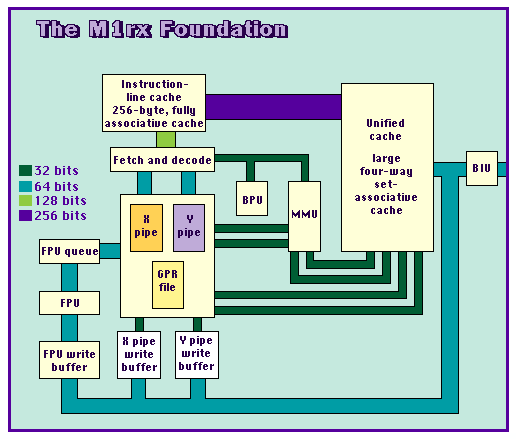| DOSSIER: Cyrix's first M1 chip, the 6x86-100, is
crippled by a monstrously large die that's difficult and
expensive to manufacture. The M1rx (a code name) addresses
that problem by using five layers of metal instead of
three on the same 0.6-micron process, which reduces the
die from 394 square millimeters to approximately 225mm^2.
This also allows Cyrix to boost the internal clock speed
to 120 MHz. Cyrix is ramping up production of both the 6x86-100 and the M1rx-120 late this year, but don't expect to see high volumes of either chip until 1996. In fact, nobody will be surprised if the large-die 6x86-100 never attains high volumes; it's so costly it will probably be discontinued after a relatively short product life. In the first quarter of 1996, Cyrix plans to optically shrink the 6x86 to a 0.5-micron, five-layer-metal process that will reduce production costs still further and increase the clock speed to 133 MHz. That version should match or exceed the performance of a 167-MHz Pentium. In the third or fourth quarter of 1996, Cyrix promises that the 6x86 will reach 150 MHz. The estimated performance would exceed that of a 180-MHz Pentium. If Cyrix is able to meet these goals, the company will likely sell all the CPUs it can make. Clock for clock, the 6x86 beats the Pentium and is competitive with In-tel's P6. Indeed, the 6x86 should easily outperform the P6 when running the 16-bit and mixed 16-/32-bit code that dominates the PC market today. Meanwhile, Cyrix isn't ignoring entry-level PCs. Although the company is phasing out 486 production late this year, it's filling the gap with the 5x86, a hybrid design that adopts some of the 6x86's features in a chip that's initially pin-compatible with 32-bit 486 sockets (see "New 486 Chips Deliver Inexpensive Power," September BYTE). The low-power 5x86 is also ideal for notebook computers. Although Cyrix has had trouble getting the 6x86 into production, the company now appears well-positioned to take advantage of the explosive growth in the PC market. The P6's poor performance with 16-bit code is a lucky break for Cyrix, because the 6x86 will be a better choice for the millions of people using Windows 3.1 and Windows 95. OFFICIAL INTRODUCTION DATE: Fourth Quarter of 1995 CURRENT STATUS: Taped out (i.e., design completed) LIKELIHOOD INTRODUCTION DATE WILL BE MET: Fair TARGET CLOCK SPEED: 120 MHz ESTIMATED PERFORMANCE: 176 to 203 SPECint92 FABRICATION PROCESS/FEATURE SIZE: CMOS five-layer metal/0.6-micron TECHNOLOGICAL ADVANTAGES: Performance is estimated to be equal to or better than that of the Pentium-150, with a 50 percent smaller die than the original 6x86-100. TECHNOLOGICAL DISADVANTAGES: Die size is still relatively large compared to that of the latest Pentiums. PRIMARY MARKET: Mainstream PCs. Where to Find:CyrixThe M1rx Foundation The M1rx will shrink Cyrix's 6x86 design
down to a more manageable die size.
Copyright 1994-1998 BYTE |